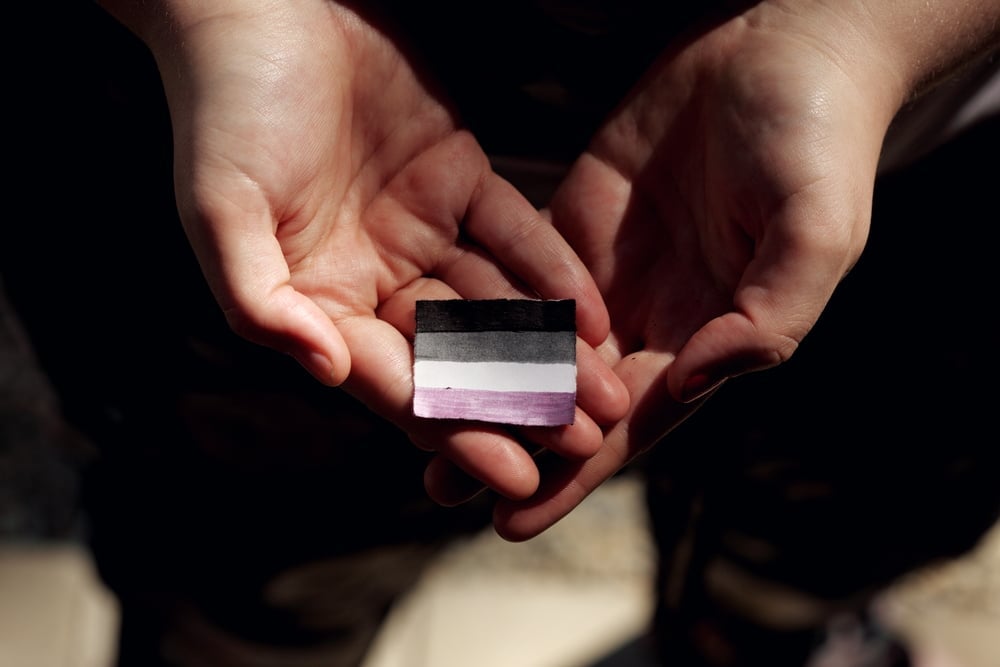Aroace: Sexual And Romantic Orientation Primer
The majority of the human population is sexual and romantic in nature, which is why there’s a lot of misunderstanding about people who don’t experience attraction the same way most do. In this article, we’ll talk about aromantic asexuals, break down the difference between sexual vs romantic orientation, and debunk a few common myths and misconceptions about aroaces along the way.
RELATED: Stonewall UK and Asexual Activist Launch First Asexual Rights Initiative
Romantic vs Sexual Orientation
Before we can define acearo, it is important to understand the difference between romantic and sexual orientation first. One way to do this is through the Split Attraction Model (SAM). With SAM, romantic and sexual attraction are considered distinct but related experiences.
Romantic Orientation
Put simply, romantic orientation is an individual’s innate pattern of romantic attraction. Whether that’s primarily toward the same gender (homoromantic), the opposite gender (heteroromantic), multiple genders (bi/pan/polyromantic), or having no romantic attraction toward any gender (romantic).
Romantic attraction manifests as an interest in engaging in romantic activities with someone, such as going on dates, holding hands, building an emotional bond connection, wanting their feelings to be reciprocated, etc.
Sexual Orientation
Sexual orientation describes a person’s sexual attraction, whether toward the opposite gender (heterosexual), same gender (homosexual), multiple genders (bisexual/pansexual/polysexual), or not feeling any sexual attraction at all (asexual).
Put simply, sexual attraction is the physical attraction and desire to do sexual activities with a person. For many, romantic orientation is inextricably linked to sexual orientation, but that’s not the case for everyone. Someone can be homoromantic, meaning only romantically attracted to someone of the same gender, but bisexual, meaning sexually attracted to two or more genders.

Katie Rainbow via Pexels
What Is Aromanticism?
Aromanticism is a romantic orientation wherein an individual experiences little to no romantic attraction toward other people. They also do not feel the desire for romantic relationships, but it does not limit them from having other forms of non-romantic relationships.
Like every orientation, aromanticism is a spectrum. Let’s break down a few of the identities on the aromantic spectrum:
- Grayromantic: Someone who experiences romantic attraction rarely.
- Demiromantic: Someone who only experiences romantic attraction after having a strong emotional connection.
- Frayromantic: Someone who feels romantic attraction toward a person they just met, which fades after an emotional connection is formed.
An aro’s romantic orientation is not dictated by their sexual orientation. Aros can still seek and form sexual relationships with other people without any romance.
Myths And Misconceptions About Aromanticism
Myth 1: Aromantic People Don’t Fall In Love
Some people think that aromantics are incapable of loving, but that is simply not true. Aros can still very much form affectionate relationships with other people, as they can form an attraction through other ways than romance. Aromantic people may (and often do) still desire relationships and emotional connections, just not romantically.
Myth 2: Aromantic People Are Lonely
Even in the absence of romantic attraction, aromantic people can have many fulfilling relationships. There are many different kinds of relationships that form an aromantic person’s network:
- Familial relationships: A familial relationship is a bond between close family members such as parents, siblings, children, and other kinships. While the term “family” traditionally refers to a social unit connected by blood or marriage, many LGBTQ people have a “chosen family” made up of unrelated individuals who support each other in the same way that a family does.
- Platonic relationships: A platonic relationship, also known as a friendship, is an affectionate and emotionally intimate relationship between individuals in which sex is neither desired nor practiced.
- Sexual relationships: Sexual relationships are relationships where people have sex. Vulnerability and trust, while great, aren’t prerequisites for a sexual relationship. While many people form romantic connections with the people they have sex with, aros are able to experience sexual intimacy without the desire to escalate it to a romantic relationship.
- Queerplatonic relationships (QPR): QPRs are non-sexual and platonic in nature, involving a very close emotional commitment and connection that is often more intense than in traditional friendship. QPRs may involve a greater degree of intimacy than friendship without the romantic and sexual elements.

Katie Rainbow via Pexels
What Does It Mean To Be Asexual?
Asexuality is a sexual orientation wherein an individual feels little to no sexual attraction or desire for physical intercourse with other people. This is in contrast to celibacy, which is a voluntary commitment to abstain from sexual intercourse regardless of attraction.
Just like aromantics, asexuals can identify along a spectrum – one list even identifies more than 150 different types of asexuality! Below are some of the sub-identities under the asexual umbrella:
- Grey-A or Grey-Asexual: Someone who doesn’t often experience sexual attraction.
- Demisexual: Someone who only experiences sexual attraction after a strong emotional bond is formed.
- Fraysexual: Someone whose sexual attraction fades once an emotional bond occurs.
Myths and Misconceptions About Asexuality
Myth 1: Asexuality Is An Illness Or Medical Condition
Even though most people experience sexual desire and attraction, there is nothing “wrong” with asexuality. It’s a perfectly natural sexual orientation – it should not be treated like an illness or medical condition that requires a cure. Asexual people do not need to be fixed or changed.
Myth 2: Asexuals Don’t Have Or Enjoy Sex/Masturbation
Asexuals may still enjoy masturbating and having sex without feeling any sexual attraction toward other people. This is because libido and attraction are two different concepts – the former is how much you want to have sex and the latter is who you want to have sex with.
Sex is still a physically pleasurable activity. Plenty of people are capable of having and enjoying sex with people they aren’t attracted to, and aces are no different. Aces may have sex for their own pleasure or to maintain relationships with non-asexual partners.
Myth 3: Asexual People Can’t Have Loving Relationships
Aces can still form meaningful loving relationships without sexual attraction. After all, sexual orientation and romantic orientation are two very different things. A person who does not seek or desire sexual contact with others can still form romantic, platonic, and other forms of relationships.
What Is Aromantic Asexuality?
Sexuality and romantic attraction don’t necessarily have to align, but they do in many cases. Combining both aromanticism and asexuality, aroace individuals do not feel any romantic and sexual attraction toward other people.
That said, aroaces can still form relationships with other people, fall in love, get married, build families, and have sex. People who identify as aroace may fall anywhere along the asexual and aromantic spectrums.
Signs You Might Be Aroace
- You don’t experience feelings of romantic or sexual attraction.
- You don’t fall in love or have crushes.
- You do not relate to romantic stories or the desire for the relationships discussed in them.
- You don’t need a romantic relationship or sex to feel complete.
- You do not feel turned on by other people.
- You do not relate to other people’s sexuality.
- You are not interested in sex.
Conclusion
Aro/aces are capable of love and affection and can form very meaningful relationships. The only difference from most other romantic and sexual orientations is that aroace relationships are not driven by sexual and romantic attractions.
At the end of the day, aromantic asexual people are not “abnormal” and don’t need fixing. Different romantic and sexual orientations remind us that the human experience is incredibly diverse, and society should accommodate all kinds of people – even and especially those who aren’t like us.
RELATED | What Asexuality Can Teach Us About Sexual Relationships







